Physical Address
304 North Cardinal St.
Dorchester Center, MA 02124
Physical Address
304 North Cardinal St.
Dorchester Center, MA 02124

Unravel Thailand's mouth-watering cuisine as you discover 13 essential dishes that perfectly balance sweet, sour, salty and spicy flavors.
Thai cuisine balances sweet, sour, salty, and spicy flavors through iconic dishes you shouldn’t miss. Try Pad Thai, the national noodle dish, alongside Som Tam‘s explosive green papaya salad and aromatic Tom Yum Goong soup. Don’t overlook regional specialties like Northern Khao Soi curry noodles or Northeastern Larb. Street food gems include Gai Tod (crispy fried chicken) and rejuvenating Mango Sticky Rice for dessert. Each bite reveals Thailand’s opulent culinary heritage.
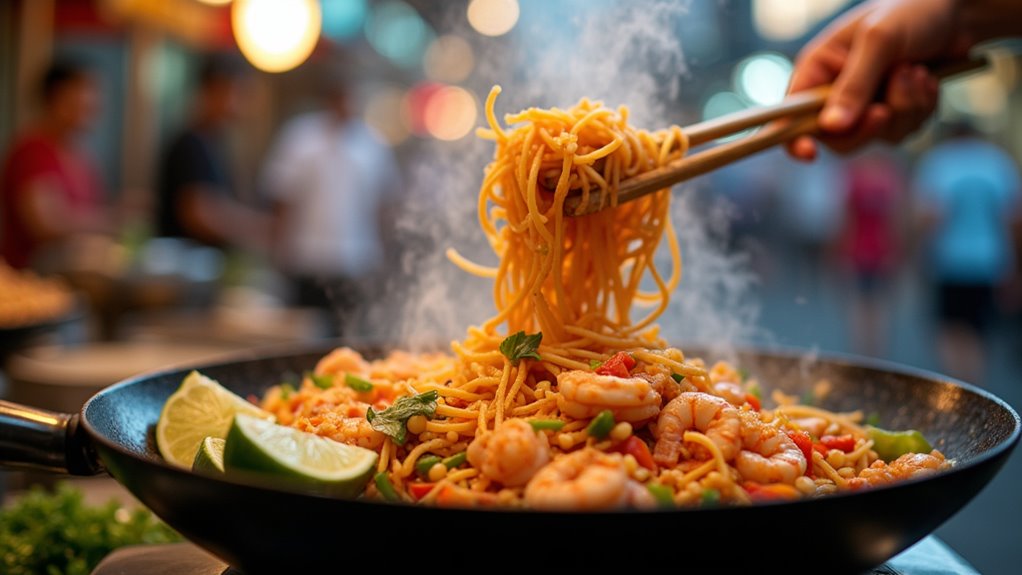
While many international dishes have ancient origins, Pad Thai emerged relatively recently in 1938 during Plaek Pibulsonggram’s rule as part of a deliberate national unification campaign.
Unlike many ancient culinary traditions, Pad Thai is a modern creation born from Thailand’s 1938 national identity campaign.
This fusion dish combines Thai and Chinese culinary traditions, coinciding with the renaming of Siam to Thailand.
You’ll find Pad Thai features stir-fried rice noodles with vegetables, bean sprouts, peanuts, and protein options like shrimp or chicken. Its distinctive sweet-sour-savory profile comes from tamarind, palm sugar, and fish sauce. The dish showcases a vibrant red color from aromatic Thai spices that enhances its visual appeal.
Often served as street food, it’s prepared quickly in a wok.
Despite its modern beginnings, Pad Thai has become Thailand’s culinary ambassador worldwide.
The dish offers nutritional balance while adapting to dietary preferences and regional tastes, making it both versatile and accessible. Visitors to Thailand can enjoy authentic Pad Thai at many Koh Phangan restaurants that serve breakfast throughout the day.
Moving from Pad Thai’s global fame, we encounter another iconic Thai creation – Som Tam, the vibrant green papaya salad that exemplifies Thailand’s bold flavor combinations.
This central Thai dish combines julienned unripe papaya with chilis, garlic, dried shrimp, peanuts, long beans, and tomatoes, creating a perfect balance of spicy, sweet, sour, and umami flavors. The Central Thai-style specifically balances sourness with palm sugar sweetness, differentiating it from its Lao and Isan origins.
You’ll find Som Tam traditionally prepared in a large mortar and pestle, where ingredients are methodically pounded to blend flavors while maintaining the papaya’s signature crunch.
At approximately 319 calories per serving, it’s both delicious and nutritious. Som Tam represents Thailand’s culinary diversity with numerous regional variations found throughout the country.
The dish’s heat level can be customized to your preference, making it accessible even if you’re sensitive to spice.
Look for this invigorating salad at street markets and social gatherings throughout Thailand.
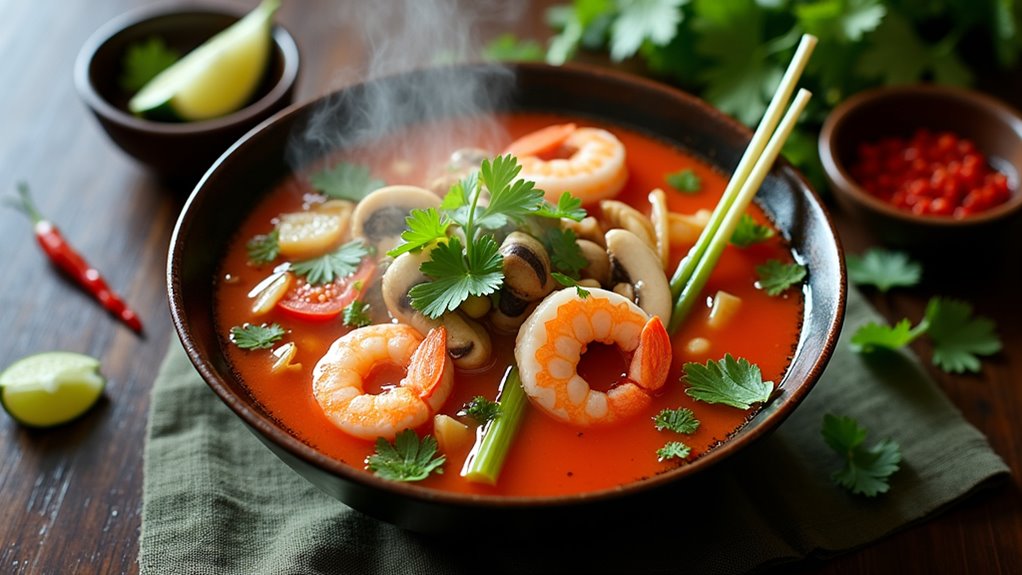
Few dishes capture Thailand’s vibrant flavor profile as perfectly as Tom Yum Goong, the iconic hot and sour prawn soup that’s become a national treasure. This aromatic soup balances spicy, sour, and savory notes in a harmonious explosion of flavors.
You’ll find whole prawns swimming in a fragrant broth infused with lemongrass, galangal, makrut lime leaves, and fiery Thai chilies. The soup’s signature tanginess comes from fresh lime juice, while fish sauce adds depth and umami. Some versions include a splash of evaporated milk for creaminess. Often considered a potential national dish of Thailand, Tom Yum Goong is widely available from humble street stalls to high-end restaurants.
The preparation is surprisingly quick – just 10 minutes of simmering allows the flavors to meld perfectly.
Locals believe in Tom Yum’s therapeutic properties, often enjoying it with steamed jasmine rice for a complete meal that’s both nourishing and satisfying. After a day exploring Thailand’s beach destinations, this revitalizing soup offers the perfect culinary complement to seaside relaxation.
Khao Pad, Thailand’s beloved fried rice, transforms simple ingredients into a vibrant one-dish meal enjoyed across the country. You’ll find this stir-fried staple cooked in a scorching hot wok to achieve that distinctive smoky “wok hei” flavor.
Day-old jasmine rice forms the base, with proteins like prawns, chicken, or tofu mixed with scrambled eggs. The dish gets its depth from fish sauce or oyster sauce, while aromatics like garlic and shallots infuse every grain. What makes this dish truly unique is its salty, garlicky profile that distinguishes it from other Asian fried rice variations.
Regional variations abound, from seafood-heavy coastal versions to vegetarian adaptations with mushroom sauce. Many travelers find themselves enjoying this comforting dish while exploring islands like Koh Chang, where beachside restaurants serve particularly flavorful versions.
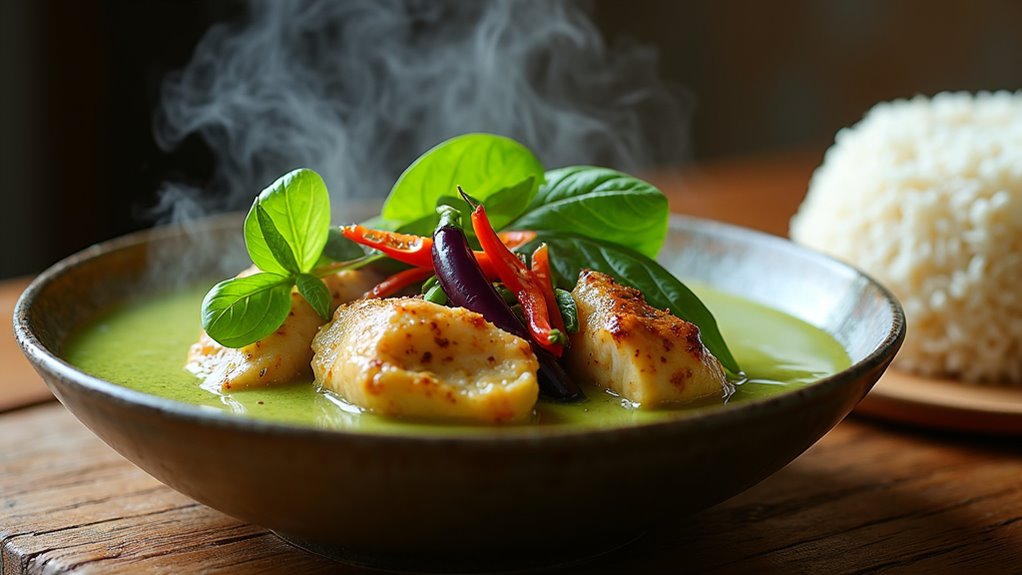
Simmering gently in homes and restaurants throughout Thailand, green curry (kaeng khiao wan) stands as perhaps the most internationally recognized Thai dish. Originating from the Ayutthaya period, it’s evolved with influences from Indian and Southeast Asian cuisines.
The vibrant curry combines full-fat coconut milk with a paste of chilies, lemongrass, galangal, and kaffir lime leaves.
You’ll find chicken, fish, or tofu swimming alongside bamboo shoots and Thai basil, with fish sauce and palm sugar balancing the flavors.
When you’re in Thailand, you’ll notice regional variations that incorporate local ingredients.
Green curry holds cultural significance beyond its delicious taste—it’s served at family gatherings and represents Thai hospitality.
Whether you’re visiting the mountainous Chiang Mai region or the coastal areas of Phuket, you’ll find this beloved curry on most restaurant menus with subtle local differences.
Don’t miss trying this aromatic dish that perfectly embodies Thailand’s complex flavor profile, typically taking just 30 minutes to prepare, making it a staple in both restaurant and home cooking throughout the country.
As you wander through Bangkok’s bustling morning streets, you’ll inevitably encounter the irresistible aroma of moo ping, Thailand’s beloved grilled pork skewers. These flavorful treats feature marinated pork neck, prized for its perfect fat-to-meat ratio and tenderness.
The marinade combines Thailand’s aromatic trinity—garlic, cilantro roots, and white pepper—with fish sauce, soy sauce, and palm sugar for that signature sweet-salty balance. After overnight marination, vendors grill the skewers over charcoal, creating a caramelized exterior while maintaining a juicy interior. During cooking, vendors continuously brush the skewers with coconut cream to keep the meat moist and develop a sticky, flavorful glaze. While Thailand has many popular destinations, moo ping is a culinary attraction you’ll find even in paradise islands like Koh Lipe where local food stalls serve this street food classic.
Pair your moo ping with sticky rice and spicy jeow som dip for an authentic Thai breakfast experience.
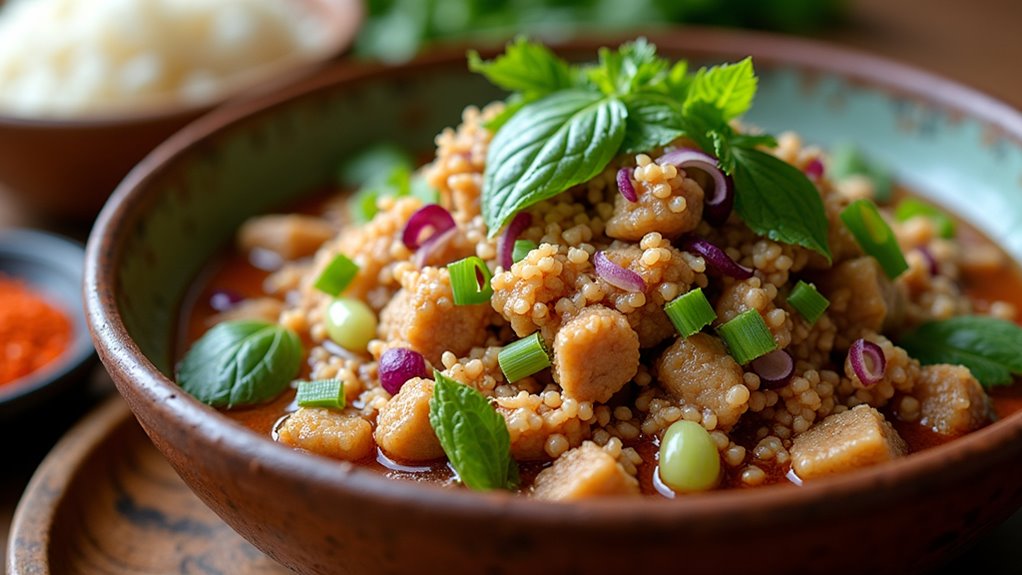
Moving from the smoky street grills to the vibrant communal tables of Thailand’s northeast, we encounter larb – a tangy meat salad that captures the soul of Isan cuisine. This celebratory dish balances spicy, sour, salty and sweet flavors in perfect harmony.
Larb welcomes you to Isan’s communal table, where every bite celebrates Thai harmony.
You’ll find larb made with ground pork, beef, chicken or vegetarian alternatives, mixed with aromatic shallots, garlic, and chili. What gives larb its distinctive character is the liberal use of fresh herbs like mint and cilantro, plus the tangy dressing of fish sauce and lime juice. The refreshing combination of lemongrass and chilies makes it particularly appealing on hot summer days.
Many traditional versions incorporate toasted rice powder for a nutty crunch.
Always served with sticky rice and often accompanied by cabbage leaves for wrapping, larb represents the northeast’s culinary philosophy of bold flavors and fresh ingredients. While popular throughout Thailand, you’ll find some of the most authentic versions in Chiang Mai, where northern Thai culinary traditions are proudly preserved.
Thai street food reaches its comforting pinnacle in khao man gai, Thailand’s beloved adaptation of Hainanese chicken rice. This Thai-Chinese fusion dish features tender poached chicken served over fragrant jasmine rice cooked in chicken fat and broth.
The star is the accompanying sauce – a pungent blend of fermented soybeans, chilies, ginger, and vinegar that transforms the mild chicken into a flavor explosion. Traditional preparation involves boiling whole chickens for about 40-45 minutes until perfectly tender.
You’ll find khao man gai served with:
The dish exemplifies Thailand’s talent for adopting foreign cuisines while making them uniquely Thai through local ingredients and preparation methods. Many visitors to Koh Phangan consider this dish an essential part of experiencing authentic Thai cuisine during their island getaway.
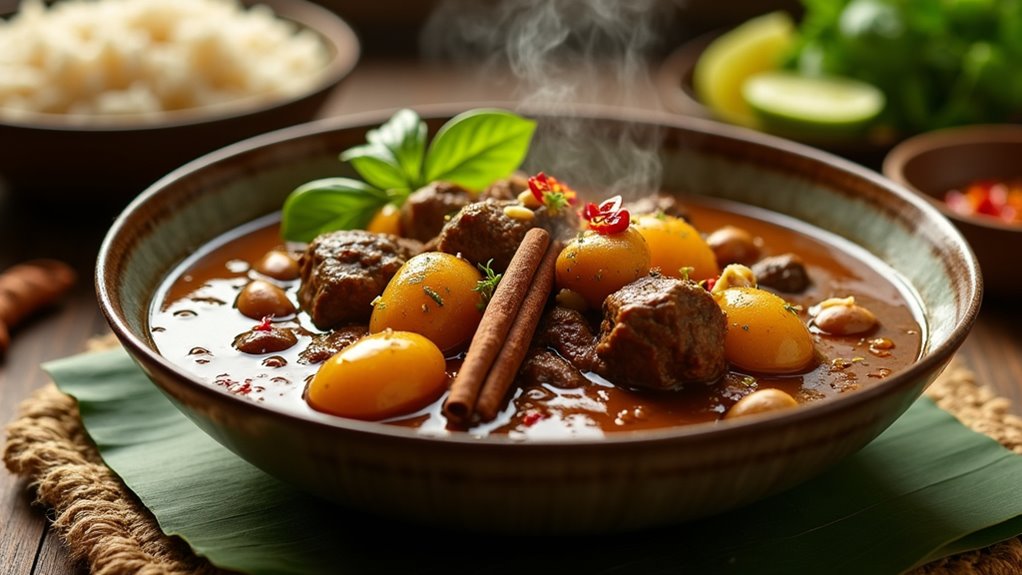
Among Thailand’s diverse curry offerings, massaman curry is highlighted as a fascinating cultural fusion with deep historical roots. This 17th-century creation blends Persian, Malay-Muslim, and Thai culinary traditions, first gaining popularity in Ayutthaya’s royal court. After spending a day catching waves on Thailand’s beginner-friendly beaches, this hearty dish provides perfect restoration.
You’ll taste the distinctive mix of cinnamon, cardamom, star anise, nutmeg, and cloves—spices that reveal its Persian and Indian trade influences. The curry features beef (uncommon in traditional Thai cuisine), affluent coconut milk, and a sweet-sour balance from tamarind and palm sugar.
Massaman holds special significance in Thai-Muslim communities, where it’s served during Eid celebrations and weddings. UNESCO recognized it as Thai cultural heritage in 2011.
Try it with roti, reflecting its Muslim origins, or jasmine rice for an authentic experience. The term “massaman” itself derives from an archaic Persian word “mosalman,” indicating its Muslim culinary heritage.
From the opulent, aromatic complexity of massaman curry, we turn our attention to a simpler but equally beloved Thai street food classic. Pad See Ew literally means “stir-fried soy sauce noodles,” a dish born from Chinese-Thai fusion that delivers smoky, savory satisfaction with every bite.
You’ll find this quick meal throughout Thailand, characterized by:
The magic happens in the wok, where rapid cooking over intense heat creates that signature smoky flavor you can’t replicate with gentler cooking methods. The authentic preparation requires cooking noodles separately from other ingredients to achieve proper caramelisation that delivers restaurant-quality results. While enjoying this dish from street vendors in Thailand, remember to maintain travel awareness to ensure both a delicious and safe culinary adventure.
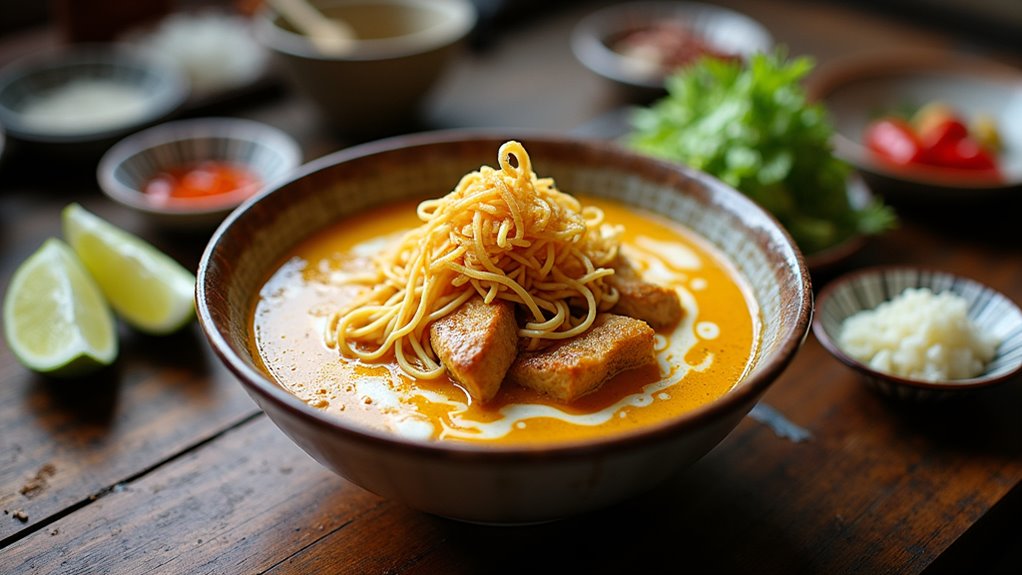
Venturing northward through Thailand’s culinary landscape, you’ll discover the hearty comfort of Khao Soi, a curry noodle soup that stands as the crown jewel of Northern Thai cuisine. This dish features an opulent coconut milk broth infused with red curry paste, turmeric, and aromatic spices.
What makes Khao Soi distinctive is its dual-textured egg noodles – soft ones swimming in the curry and crispy fried ones sprinkled on top. The dish’s history can be traced to Chinese-Muslim Yunnanese immigrants who brought similar recipes from Burma. You’ll typically find it served with chicken, beef, or tofu, and garnished with lime wedges, pickled mustard greens, and fresh cilantro.
With Chinese and Indian influences from ancient trade routes, Khao Soi has become a cultural staple at family gatherings and street food stalls throughout Chiang Mai and surrounding regions. While enjoying the northern specialties, many travelers plan to later experience the culinary contrasts in southern Thailand islands where seafood dominates the local cuisine.
After savoring Northern Thailand’s aromatic curries, you’d like to finish your meal with something sweet. Mango sticky rice (khao niew mamuang) is Thailand’s national dessert, originating from the Ayutthaya period and perfected during King Rama V’s reign.
This simple yet elegant dessert combines:
Glutinous rice mingles with fresh mangoes and coconut cream, creating a harmony of textures and tropical sweetness.
You’ll find this iconic treat everywhere during mango season (March-May), from street vendors to upscale restaurants. The dessert has been mentioned in Thai poetry written by King Rama II, highlighting its historical significance. Modern adaptations include matcha-flavored rice and vegan versions, but nothing beats the traditional preparation with its perfect balance of chewy, creamy, and sweet elements.
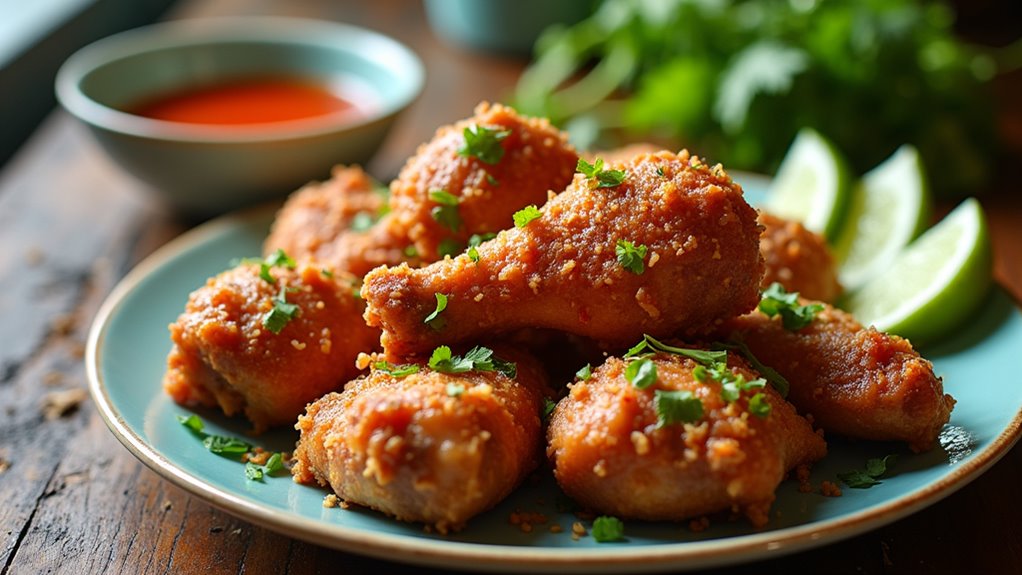
While you explore Thailand’s vibrant food markets, you’ll inevitably encounter the irresistible aroma of gai tod wafting through the air. This crispy fried chicken is a beloved street food staple, typically marinated in a pounded paste of garlic, cilantro, and white peppercorns for 24 hours before frying.
The rice flour coating creates that signature airy crispness, while fish sauce and palm sugar provide the perfect savory-sweet balance. You’ll find regional variations throughout Thailand—Hat Yai-style comes with crispy shallots and bold spices, while Bangkok versions feature a thinner crust with oyster sauce marinade. Many Thai homes and street vendors use a large, heavy-based pot for deep frying to ensure safety and optimal temperature control.
Typically priced between 40-100 THB, gai tod is commonly served with sticky rice, cucumber slices, and spicy dipping sauces. It’s an essential comfort food that showcases Thai culinary ingenuity. Even at the famous Full Moon Party on Koh Phangan, you’ll find vendors selling this crispy delight to hungry revelers looking for late-night sustenance.
Thailand’s food culture will absolutely blow your mind with its balance of sweet, sour, salty, and spicy flavors. You’ll find these dishes at street stalls and upscale restaurants alike. Whether you’re craving noodles, curries, or unforgettable desserts, Thai cuisine offers something for all. Don’t leave without trying at least a few of these iconic dishes—they’re the tastiest way to experience Thailand’s culinary heritage.